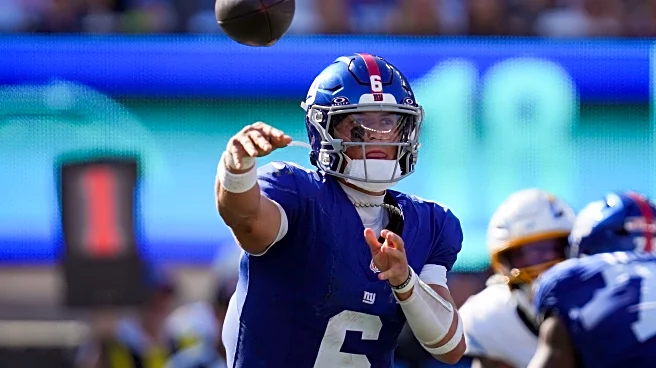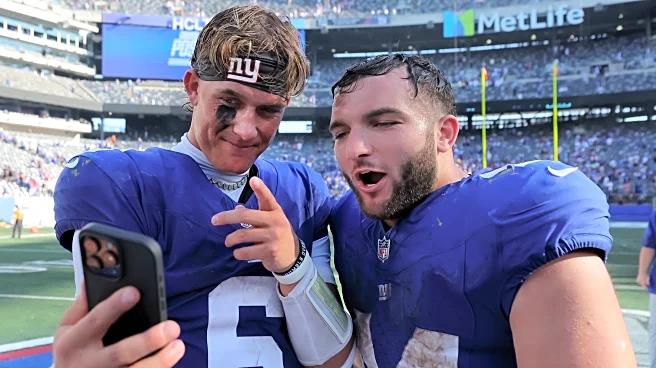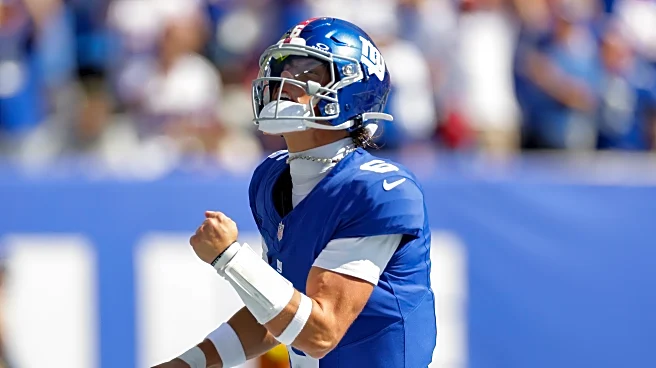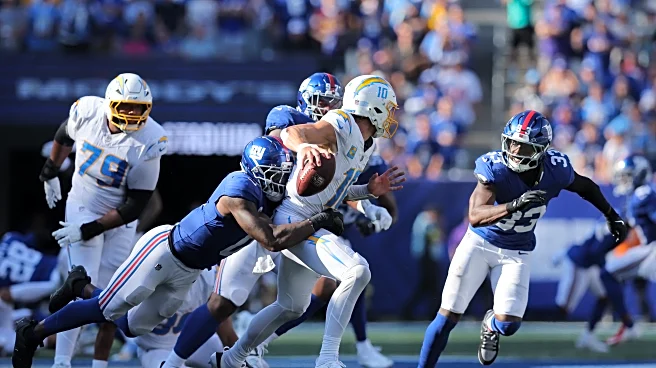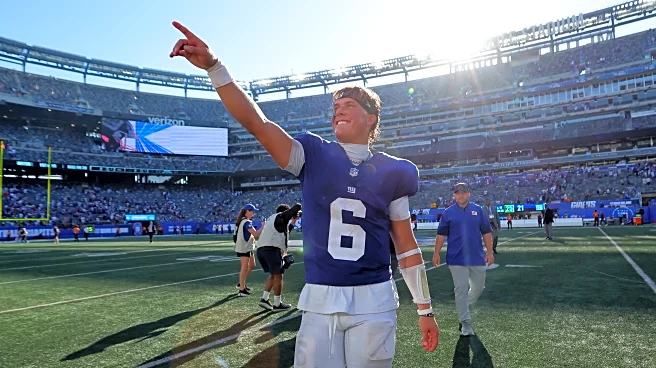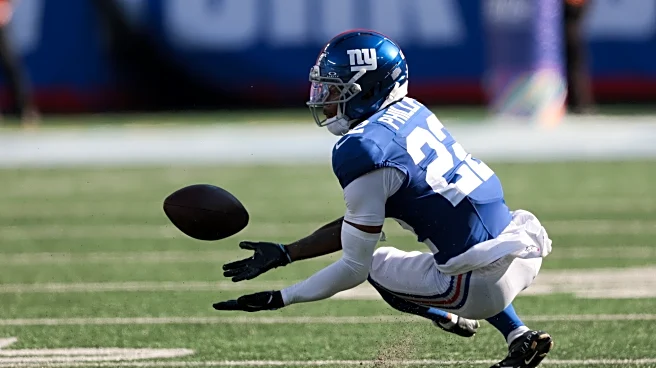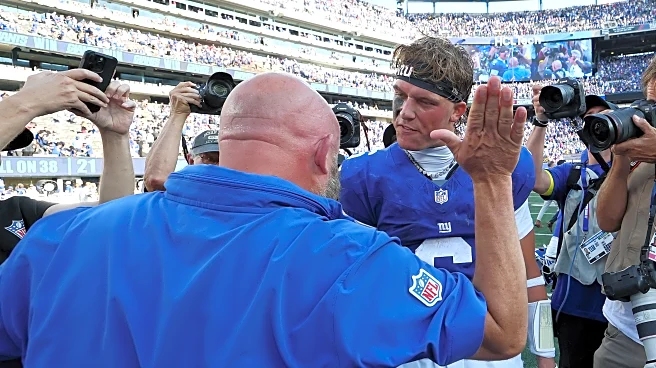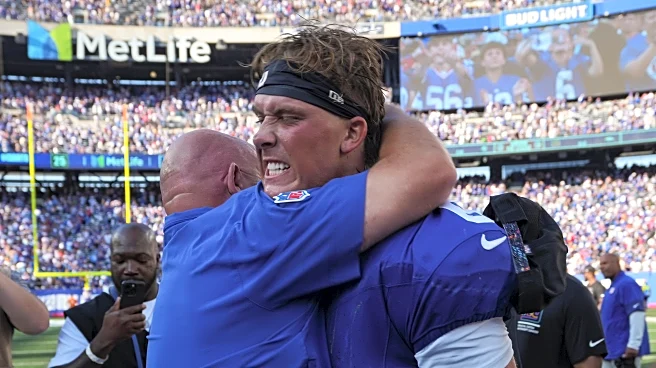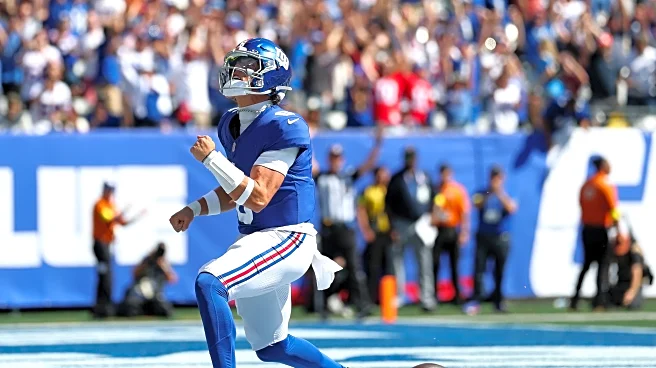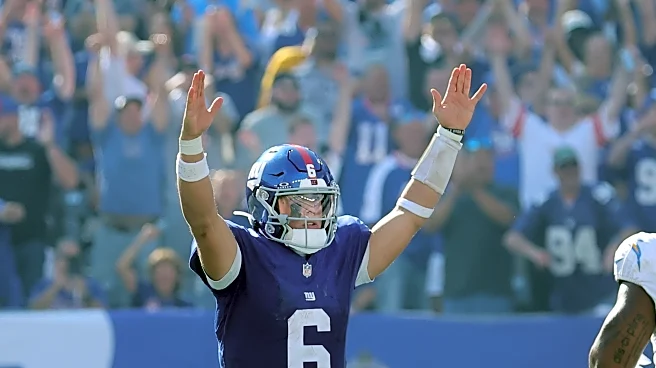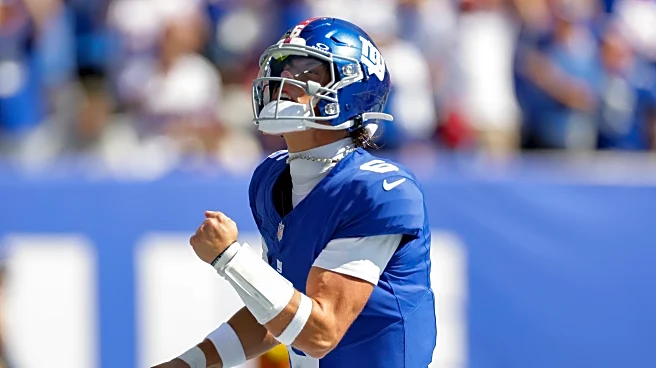The New York Giants defeated the Los Angeles Chargers, 21-18, in Jaxson Dart’s first career start. Dart became the first quarterback in the last 20 years to win his first career start against a team that was 3-0 or better, according to CBS.
Dart did not set the world ablaze against a Jesse Minter coached defense that allowed just 158 passing yards per game before Week 4. Dart finished 13 of 20 for 111 yards (5.6 average) with one passing touchdown; he added 54 yards on the ground on ten carries, along
with a rushing touchdown. Dart was sacked five times.
The rookie quarterback had a 65% completion rate with a +0.63 clean pocket EPA per dropback, and a 96.0 passer rating. His overall EPA per dropback was -0.06.
The Chargers primarily used nickel personnel (60% of the time) and they used a few different DIME personnel looks as well (24% of the time), while blitzing at a season high 47% rate; a lot of those “blitzes” were simulated pressures, but the rate was still higher than any of the previous three games.
Overall, one must be pleased with a rookie quarterback who won a game after losing the fulcrum of the offense to a torn ACL. Still, the game plan was rudimentary from a passing perspective, which allowed the Giants to run the football 42 times. The Giants rushed 27 times against the Kansas City Chiefs in Week 3, which was their previous high of the season. When an offense leads the entire game, running the football becomes a conservative crutch to lean on as the clock gets closer to zero.
The Giants did not reinvent the wheel with Dart under center. The offense was rudimentary and conservative, but the threat of the rookie’s legs kept defenders in place. The Giants’ rushing plays were tagged with RPOs that also forced defenders to exhibit discipline. Fake tosses to the outside horizontally displaced defenders, which created openings for backside routes.
Nine of Dart’s 13 completions were either passes to the flat, a simple three-route shallow horizontal stretch combination, or a shovel pass underneath (the Theo Johnson touchdown). Dart found the stick route (once to Malik Nabers and twice to Darius Slayton) on the aforementioned horizontal stretch combination. His other four completions were a pair of 13-yard passes to Daniel Bellinger and Nabers, as well as the 18-yard comeback to Darius Slayton, and the 10-yard catch to help seal the game to Theo Johnson.
Let’s go through those five completions.
Five Jaxson Dart throws
On the Giants’ opening drive, Dart foundNabers over the middle of the field for 13 yards one play before calling his own number on the 15-yard QB draw for a touchdown:
New York aligned in an EMPTY formation and ran a switch release to the three receiver side that occupied the safety. Nabers was aligned as the slot receiver on the two-receiver side on this first-and-10 play. Minter dropped two defensive linemen off as underneath defenders or spies for Dart, with just two rushers. As Dart attempted to use his legs, his space was restricted by the big spies, so the rookie located Nabers, who out-paced Daiyan Henley (0) just enough to allow Dart to find Nabers for a first down with an unconventional release.
Dart certainly has the off-platform magician trait as a thrower. While the pass above to Nabers isn’t perfect, it’s accurate enough to allow Nabers to come down with the football, while two defenders were closing in on the thrower, with a defender overtop and underneath Nabers.
On the Giants’ second drive, Dart was backed up on his own goal line, still, after a pair of failed runs against a tough defense. I greatly appreciate the command he displays in the play below:
New York sets a seven-man protection with Daniel Bellinger (82) and Devin Singletary (26) against a blitzing Chargers’ front. Dart calmly stepped up and away from pressure, buying time to his right while communicating with his veteran receiver to turn his fly-route into a comeback. Dart then makes a Derek Jeter type of leaping throw to hit Darius Slayton (18) in the numbers for a first down. New York would pun three plays later after Dart suffered a third-and-10 sack.
Brian Daboll had an excellent challenge on the Giants’ 15-play, 47-yard drive, where Dart found Bellinger over the middle of the field for 13 yards in the middle of the second quarter.
Los Angeles aligned in an inverted Cover-2 with the Tampa-2 MIKE (pre-snap field safety), carrying Malik Nabers with inside leverage. The attention Minter paid to Nabers was a sign of respect, as the Chargers bracket him from the slot, with the middle-hook defender also sprinting underneath Nabers’ route. That, however, allowed Bellinger to sit in the voided area underneath Nabers’ vertical. Dart hit his back foot, hopped up in the pocket — may have thought about running — but kept his eyes downfield to find Bellinger for the first down.
The Nabers’ effect; he took two defenders deep and removed Troy Dye (43) from the box for Bellinger as the free safety, Derwin James (2), watched Cam Skattebo (44) out of the backfield to the boundary side.
Dart and the Giants desperately needed a first down with 2:38 left in the game, with just a three-point lead. Dart was able to extend the drive to force the Chargers to burn their final time out, with precious seconds ticking off the clock on the ensuing plays:
Coach Daboll discussed the leadership and teamwork displayed by Dart and Theo Johnson (84) on this ten-yard grab. Daboll mentioned that Dart told Johnson to sit if zone coverage was presented, so Johnson sat like a tired geriatric at an amusement park. The Giants run Y-Cross often, and we saw this play several times through the game and the season, where Johnson continues his crossing route behind the linebackers and in front of the safeties. In the crucial play above, Johnson sat in the peripheral of Henley, and Dart progressed toward the big tight end after the stacked smash concept didn’t appear as enticing to the quarterback.
Spacing concept for the win
The Giants connected on three spacing plays underneath that resulted in seven, seventeen, and nine-yard gains. All three of the plays were run out of a boundary stack with a running back to the same side. The goal of a spacing/snag concept is to stretch defensive zones horizontally. All three of the plays are run out of the same formation to the same side.
(Second-and-8)
The catch by Nabers was against a Cover-4 look, where Johnson removed the inside defender, and Skattebo forced the curl/flat to match him on the flare, giving Nabers space horizontally with the responsible defender being six yards off of him. Dart quickly saw the curl/flat cross the face of Nabers, and promptly delivered the football to the stick route to set up a third-and-1.
(Second-and-16)
One can really see how the simple concept stresses and stretches the defensive zones on the 17-yard effort by Slayton. This was the first play of the fourth quarter on a second-and-sixteen against Cover-3, with a Wan’Dale Robinson (17) motion from the backfield to the field slot right before the snap (not captured).
(First-and-10)
The Giants went back to it a few plays later. I expect the Giants to rely on this quick concept for their quick passing attack. Defenses will scheme to eliminate the concept, and it will be on Dart and the offense to get to the backside cross and dig if the defense is effective.
Incomplete passes
Thrice, Dart attempted to connect with receivers downfield after confirming a pre-to-post snap safety rotation. The second was Nabers’ injury, where Dart confirmed the offside and took the one-on-one shot, which sailed incomplete, but the first one was the confirmation made by Dart below:
(Second-and-10)
The Chargers were ready for the Y-Cross by Johnson. They rotated the weak-side safety down into the box to buzz and prevent Johnson from gaining leverage against an outside-positioned defender. Dart saw the buzzing safety and knew he had a one-on-one matchup with Darius Slayton (18) deep. The ball is just out of Slayton’s reach, but it was still catchable, albeit difficult. The Chargers had two sets of eyes on Nabers toward the bottom of the screen, so I appreciate that Dart took his shot toward the veteran even though it went incomplete.
(First-and-10)
Dart also missed this boundary Post/Wheel to Johnson, where Nabers cleared the deep third, and the curl/flat forced to carry Johnson toward the sideline. The Chargers were disciplined in their rush lanes, and Dart had little time to deliver the football on the play-action.
(Third-and-7 )
Dart was quick to diagnose the blitz and see the middle of the field vacant of a safety. We can’t see it on the clip, but he communicates this to the team and got on the same page with Slayton. He took his shot to Slayton, who drew a defensive pass interference call that helped the Giants set up Jude McAtamney’s 31-yard field goal. Love this processing and awareness from the rookie.
The Giants have struggled in the red zone through four games. Entering Week 4, the Giants were second-to-last, ahead of only the Houston Texans, in red zone touchdown rate. They scored two red zone touchdowns and converted a two-point conversion, which is positive news, but there were still issues; however, they should have had a third touchdown:
(Fourth-and-goal)
New York froze the defense with a fast motioning Skattebo, which created a mesh point to try and force positive leverage from the Giants’ receivers. Robinson slid underneath Dart, Johnson, and Slayton’s corner routes, creating a short field three-level read for Dart in a condensed area. Los Angeles played it well, with Jalin Hyatt (13) as the backside crosser. Dart, however, did a great job extending the play with his legs and making multiple defenders miss in the pocket.
Dart rolled right upon realizing that Skattebo was not open in the opposite flat either; Dart drew multiple defenders toward him and then threw a catchable pass to a 5-foot-8 wide receiver, who grabbed the ball but failed to secure it to the ground. It’s frustrating that the 6-6 tight end did not come up with the football, but the ball was closer to Robinson, who was slightly more open despite his diminutive frame. These are the types of off-script throws I know Dart has in his bag; he displayed them at Ole Miss and a few times throughout his short tenure in the NFL. He’s a threat with his legs and defenses must respect that.
Moxie alert
Dart provides a serious energy to the team. He possesses a fearless style of play that — I wish — some others on the team would emulate. With that said, however, he does need to be wiser and get down. I love the passion and grit, but injuries are all too real in this game. The second clip below is a third-and-10 conversion with his legs, where he did a good job getting down!
The QB draw was one of the more successful plays run by the Giants all game. Dart also did well to secure yards with his legs off scrambles; 23 of his yards (that counted) were off scrambles, and the first play above would have added an extra 50 yards if it wasn’t negated by a John Michael Schmitz (61) holding penalty.
Needs improvment
Dart suffered five sacks, and it could be argued that all five were on the young quarterback, who held onto the football too long. The issue with indecisiveness will crop up from time to time, as will tunnel vision:
(Third-and-14)
Dart seemed locked on Hyatt’s deep corner route against a Cover-4 pre-to-Cover-1-post snap rotation, when the leverage against Beaux Collins (81) never changed on the side of the field where Dart’s eyes appeared. Dart kept his eyes on Hyatt and the safety, it appears, when Robinson (17) had leverage against a safety that dropped and Collins was cleanly open at the sticks on the curl. The Robinson leverage may have been erased by the deep MOFC safety, since that safety stayed square to Hyatt on the hash for an extended period of time.
Plays like the sack below were to sparingly be expected:
The Chargers sent a simulated pressure with an unblocked defender due to the blitz that Jermaine Elueumunor (72) had to pick up in the B-Gap. Dart saw how the Hyatt motion shifted defenders and thought he had Nabers on the in-route after the immediate movement from the Chargers’ defenders to the boundary side; it was a ruse, though, and the Chargers sank underneath Nabers, while the young quarterback failed to account for the unblocked Tuli Tuipulotu (45). Mistakes like this, with protection, are to be expected but learned from.
Dart also was not precise with his ball placement. He missed a few throws over the middle of the field and sailed a few out of bounds, albeit the one to Slayton on the streak was catchable. It is something the young player likely wants to clean up.
Final thoughts
The Giants constructed a conservative — run oriented — game-plan against the Los Angeles Chargers, and Dart executed it adequately. Was it perfect? No, but he showed command and did enough to take advantage of two turnovers that allowed the Giants to secure their first win of the season, especially through the adversity of losing Malik Nabers in the first half. Overall, it was pleasant to see the Dart era start.
